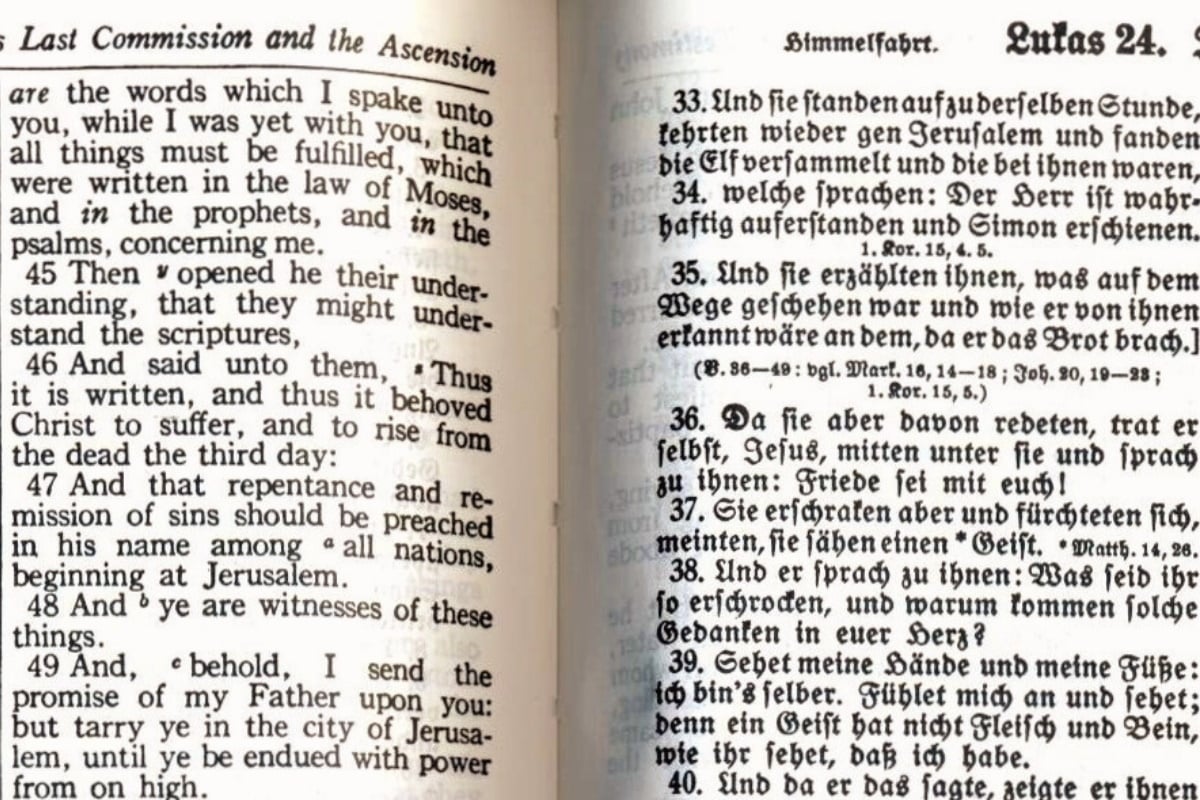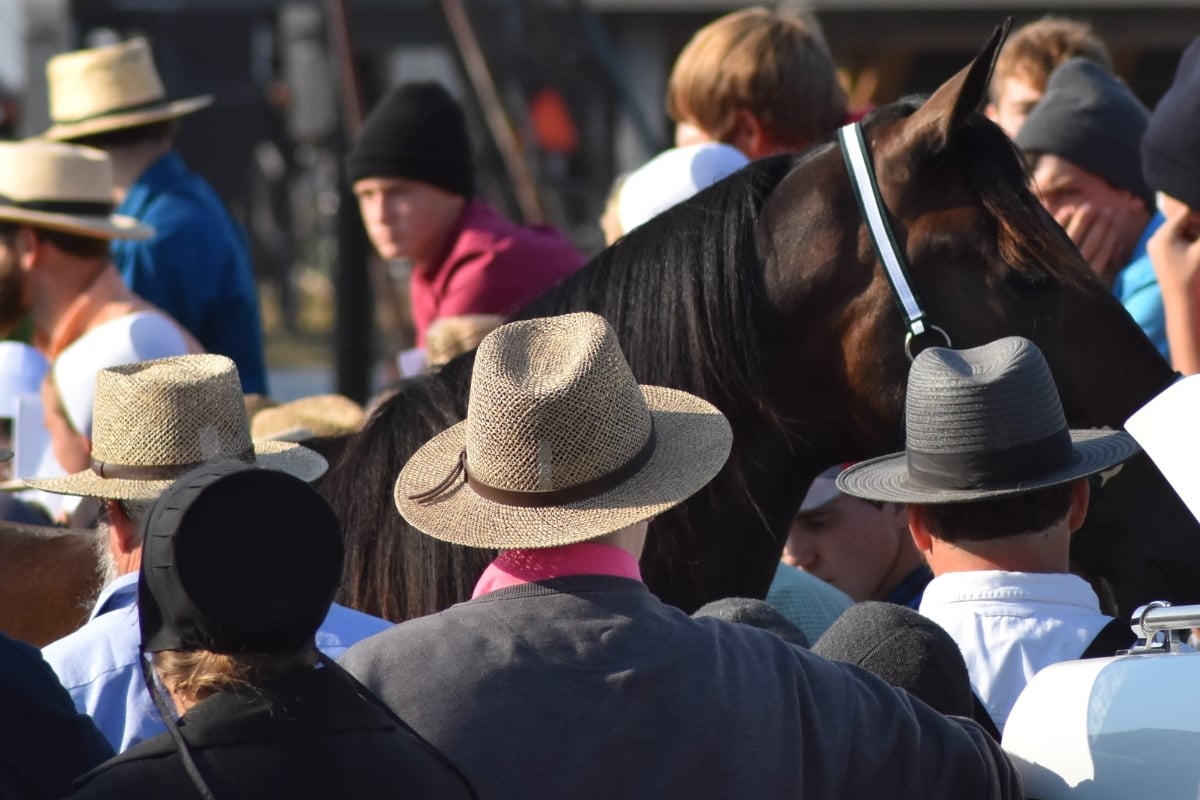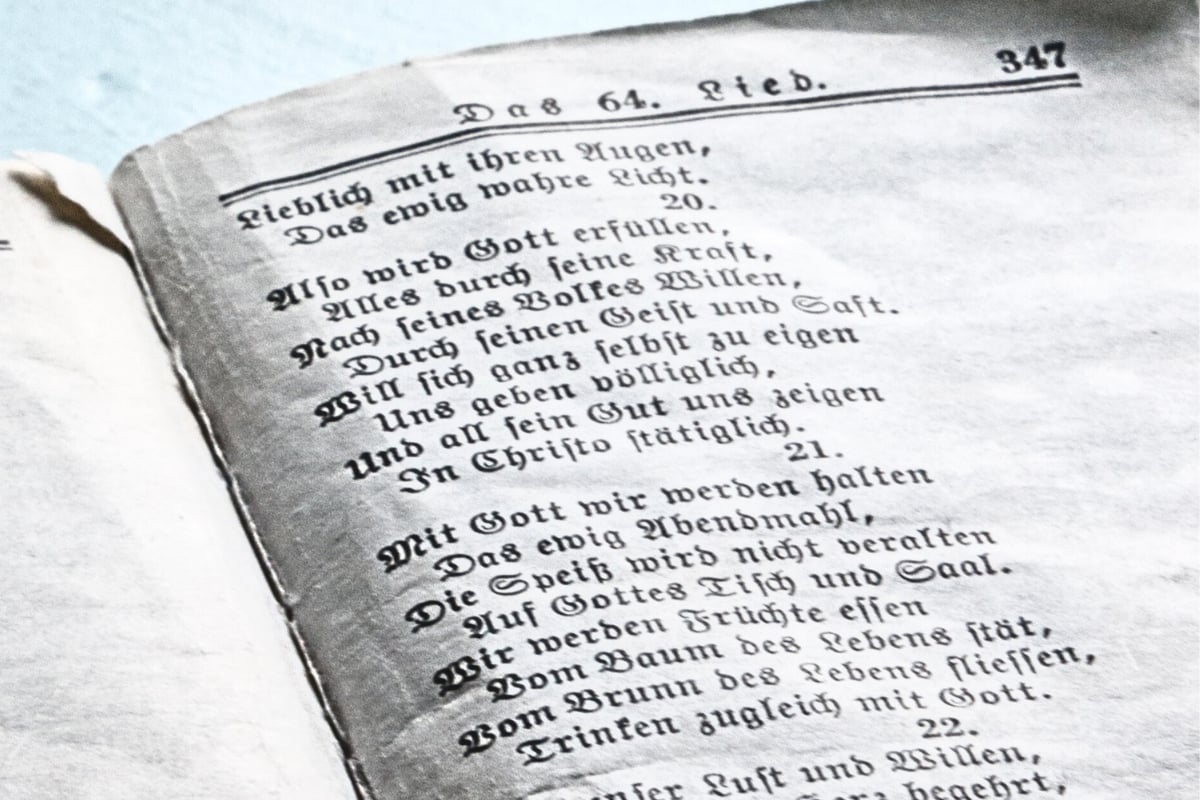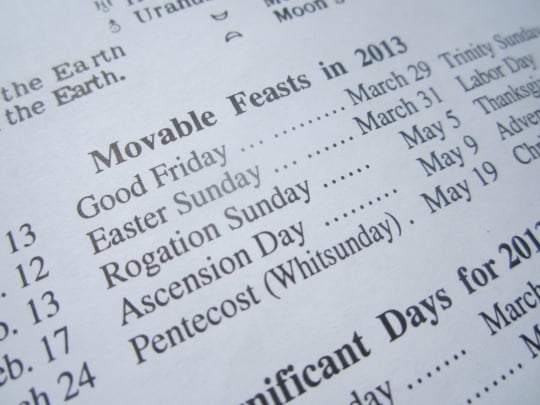Do Amish read the Bible? Which Bible do they use?
Amish use both English and German Bibles
 The Amish use the German Martin Luther Bible in church. For an English version, they typically use the King James translation, though some Amish may use the New International Version (NIV). The language the Amish speak, Pennsylvania German (aka Pennsylvania Dutch), is generally not a written tongue, though there have been attempts made to create a Bible in the Pennsylvania German language.
The Amish use the German Martin Luther Bible in church. For an English version, they typically use the King James translation, though some Amish may use the New International Version (NIV). The language the Amish speak, Pennsylvania German (aka Pennsylvania Dutch), is generally not a written tongue, though there have been attempts made to create a Bible in the Pennsylvania German language.
The Amish do read the Bible, but not necessarily in the same ways that other Christians do. Seeking personal interpretations that challenge the community, or putting on bold displays of Biblical knowledge are not encouraged – though reading for personal inspiration is encouraged. More on that below.
The “Amish Bible”
The Amish use both the Old and New Testaments, and preachers will use Old Testament stories in their sermons. But all Biblical texts read in church service come from the New Testament. The Amish place a special emphasis on the Gospels (books of Matthew, Mark, Luke, and John) and the teachings of Jesus Christ.
As mentioned, the Amish use both the High German Martin Luther Bible, as well as the King James version. They will typically have a dual-language Bible which presents the King James version on one page, and the Martin Luther German text on the opposite page.

Many Amish people may in fact be more comfortable reading an English-language Bible. This is because the use English fairly frequently (daily), as opposed to High German, which is more often used in a church context.
Amish & the Apocrypha
Notably, the Amish also (to some degree) use the books of the Apocrypha. The Martin Luther Bible used by the Amish contains these additional books, which Luther himself called “books which are not considered equal to the Holy Scriptures, but are useful and good to read.”
These additional books are used in some Christian churches, but not in others. Amish may draw from certain books of the Apocrypha in certain situations. For example, the story of the marriage of Tobias and Sarah may be recounted in Amish weddings, which may also include verses from the book of Tobit. The book of Nicodemus may also be used.
Do Amish read the Bible?
You may have heard the claim that “Amish do not read the Bible“. This claim is often coupled with suggestions that Amish are “forbidden” by their bishops to read the Bible, with Holy Scripture in essence being controlled by the church ministry.

Where do these claims come from? Now, as with most things Amish, we always ought to note that the customs in different Amish communities can vary. In some communities there may be a greater emphasis, or at least acceptance of studying the Bible in an individual or small-group context.
When do Amish read the Bible?
I’ve personally taken part in reading the Bible with Amish people on multiple occasions. For instance, when I’m staying with my Amish friends, it’s typical that we read some passages from the Bible after breakfast.
Or, on the “off” Sunday (the Sunday when Amish don’t hold church service in their district), they’ll read the Bible, and have devotionals, and they’ll have prayer time together as a family. There’s not a lot of extensive analysis and discussion, though there may be some. Also, Amish people will reference stories and lessons from the Bible in private discussion as well. It is not taboo to discuss the Bible.

In other communities, however, Bible reading and discussion may be discouraged, at least to some degree. Why might this be the case?
The Bible & Amish Community
Let’s have a look at a book on Amish spirituality called The Amish Way: Patient Faith in a Perilous World, which has a good explanation for this, broadly speaking. The authors note:
But even though they use the Bible in devotional settings, they understand it to be primarily the church’s book. A resource that, like every other part of life, cannot be properly or fully understood by a lone individual, or even by a small group of individuals apart from their local church.
So the context with the Bible, like with other things Amish, is “community”. The Bible is seen or approached through the lens of community, and private revelations or interpretations of the Bible are discouraged.
The Bible is also not taught in school – no Bible classes in Amish schools, or Sunday School (with one notable exception, see below). School teachers will simply read to the class from the Bible at the beginning of the day, but without teaching or in-depth interpretation. As the authors note, “the Bible is an authority to be obeyed more than studied or analyzed.”

The Amish do read the Bible in church worship – at least one full chapter (The Amish Way notes that this is significantly more than is read in most Protestant or Catholic worship services).
What about Bible study groups?
Private devotional reading of the Bible is generally accepted by Amish church leaders, or even encouraged. However in-depth Bible study in the traditional evangelical Christian mode is not encouraged. Amish feel this may lead their church members to “individualistic interpretations.” More on that from The Amish Way:
Those who show off their Biblical knowledge or claim special revelation for their acts are seen as haughty and divisive because they turn the Bible on its head, using it as a tool for self-interest rather than as an authority to which individuals must surrender.
Furthermore:
Occasionally, some individuals study the Bible and declare a private revelation, such as, “The Lord led me to start a new prison ministry program.” “We are not to make the Bible suit our way of thinking,” one minister warns. The Amish believe that the Lord guides a body of believers who diligently seek God’s will. And in Amish life that body is the local congregation.
There is also a concern that Bible study may be used as a vehicle to amplify grievances against church leadership:
Amish skepticism of small group Bible study arises because sometimes unhappy church members or former members use small group Bible study to challenge church authority. The Bible, said when Amish man, is a mirror to examine ourselves, not a spotlight to shine on other people’s shortcomings.
So for these reasons, loud proclamations of personal Biblical revelation or insight are not looked upon favorably. Again, the Amish are a church community-focused group which acknowledges the individual – but emphasizes unity and the community good. The Amish also emphasize the value humility. This applies to daily life and also to their spiritual lives.
This approach is also seen in the Amish celebration of twice-yearly Communion. Prior to Communion, the Amish review and affirm the church Ordnung (rules and standards) at a service known as Council Gmay. Communion may be postponed if there is disunity in the church, until any internal discord is resolved.
The Amish are not the same as evangelical Christians
If you look at how the Amish read the Bible from the perspective of a Christian group which emphasizes Bible study, personal interpretation and promoting individualized revelations, you are probably more apt to see the Amish as a group that “doesn’t read the Bible” (or maybe, “doesn’t really read the Bible”).
That is likely where a good bit of this idea comes from. Claims that the Amish don’t read the Bible also seem to often originate with former Amish people, who have emerged from the Amish and adopted a more traditional evangelical Protestant mode of Christianity.
That noted, in some of the most conservative Amish churches, reading of the Bible may in fact be actively discouraged in ways that it is not in the more mainstream churches. The Amish are a diverse group of over 2,000 individual church congregations, each with its own leadership and with varying rules, standards, and customs. But, the above holds generally true for how the Amish approach reading the Bible.
The New Order Amish & Bible Study
There is one exception to the idea that Amish do not promote formal Bible study. The small group of churches known as the New Order Amish (or, less commonly, “Amish Brotherhood”), do hold Sunday School. These gatherings, which are held for both adults and children in the church community, are more alike to the traditional evangelical idea of “Bible study”.
Adults and children will gather separately and passages from Scripture will be discussed as a church group (males and females also meet separately for Sunday School). The New Order Amish church, which makes up approximately three percent of all Amish, differ from other Old Order Amish churches in demonstrating a more evangelical and mission-minded outlook than is typical.
Other books and publications read by the Amish
Besides the Bible, the Amish use and read a variety of other books, both in church contexts and for non-religious reading. Here are some examples.
Ausbund – the Amish songbook
Amish also use a special songbook known as the Ausbund. The Ausbund is the longest-lived songbook in continuous use. The hymns it contains are hundreds of years old, and were composed by Anabaptist forefathers. Common themes include human suffering and faith in God.

The Ausbund contains no musical notes, and tunes are passed down from one generation to the next. Amish often get together in order to practice singing from the Ausbund.
Martyr’s Mirror
The Martyr’s Mirror is an important book for Amish as well. It is an historical account of the suffering of Christian martyrs. There are many stories of persecution of early Anabaptists, predecessors to the Amish in Europe. Amish take inspiration from the tales found in the Martyr’s Mirror.
Bible Story Books
Amish families often buy their children Bible story books. Popular sets include the Arthur Maxwell series as well as the Family Bible Library. Classic children’s books are commonly seen in Amish homes as well, as well as traditional readers.
Popular Religious Books
Some Amish read spiritually-themed magazines and books. A number even read the more popular religious authors such as Max Lucado, John Maxwell, and Rick Warren.
Fiction books
Works of fiction are not very common, but are found in some Amish homes. There is likely a significant contingent of readers of Amish fiction among Amish themselves. Books on history are popular as well as biographies and books on the natural world.
News sources
Additionally, Amish read newspapers, often local editions. Amish produced newspapers such as The Budget or Die Botschaft are very popular. Some Amish may subscribe to national news magazines.
For further information, see:
The Amish Way: Patient Faith in a Perilous World, Donald B. Kraybill, Steven M. Nolt, and David L. Weaver-Zercher
The Riddle of Amish Culture, Donald B. Kraybill
The Amish and the Media, eds. Diane Zimmerman Umble and David Weaver-Zercher; esp. chapters eight (“Inscribing Community: The Budget and Die Botschaft in Amish Life”, Steven M. Nolt) and nine (“Publish or Perish: Amish Publishing and Old Order Identity”, Karen Johnson-Weiner)






purchase a bible
Can you recommend a site to purchase a German Martin Luther bible that would be used in an Amish home. Or a typically used Bible in an Amish home.
Thank you for your assistance with this matter.
Where to find a German Luther Bible
Margaret and Erik,
Another place to find a German Luther Bible is from an organization called the Trinitarian Bible Society; they sell an older translation from 1912. More recent German Luther translations can be ordered from Germany.
Gospel Publishers prints the King James in parallel with the 1912 Luther Bible. The German text is printed in a gothic font; the Trinitarian Bible Society edition uses a roman font. The Crossway edition mentioned above has more recent German and English texts.
You can get a Luther Bible through Amazon.com or go ask your local Christian bookstore if they can order it for you. Quite a few pop up in our database at the bookstore where I work.
Crossway Publishers has a bilingual Luther/English Standard so you can see the German and English side by side–this is also found on Amazon (or possibly your local Christian bookstore).
And Lehman’s (lehmans.com) sells a bilingual New Testament English/Pennsylvania Dutch
Free biblingual KJV and Martin Luther Bible
My website at luther.woodwardworks.com contains a bilingual bible where each verse is displayed once in KJV english and then again in German (from the 1912 version of Martin Luther’s translation of the Bible).
Each book of the Bible can be read online or downloaded as an EPUB or a PDF. There is no charge for this. The EPUB version is not protected by DRM (Digital Rights Management), so it can be converted to other formats easily with appropriate software (such as the free download of the ‘calibre’ program.
For those who want to avoid converting of the EPUB books there is also provided a link to Amazon’s website for many (but not all) of the books. A small fee is charged by Amazon, however, if you download from their website.
I have changed my website http://luther.woodwardworks.com. There are now two online bibles for Martin Luther’s Bible Translation.
Both are free to use. One is Luther’s final translation in 1545 which is entirely in German.
The other is a bilingual bible with each verse of the Old Testament and the New Testament displayed three ways. First the verse is displayed as it appears in English in the 1886 King James Bible. The next line shows the verse as it appears in the the 1912 German translation of Luther’s Bible. Finally, the third line displays the verse as it appears in Luther’s 1545 translation (translated by Martin Luther just before his death). Note that cross-references and notes are not shown in the bilingual Bible.
Website link?
Greeting,
I am writing to ask for the website you posted for to download or view the german and gothic print bibles? Your links do not work as of the time of this posting, so now I kindly await a response.
God bless,
Christian M.
Using The Ausbund in What Bible do the Amish Use
Please explain how The Ausbund un-printed tunes are known and passed down through the generations. Thank you so much. I love reading the posts as much as Erik’s articles. Blessings to all who love Amish America.
Thanks Carolyn, it’s done in the same way stories or songs in other cultures are passed on–they are simply heard and practiced and used in church, so they stay alive from one generation to the next.
K.J.V. bible said go teach and preach God,s word and do sole wining is this part of their thinking. Thank You
John thanks for your question, I think you are referring to mission work and evangelization? These two posts might provide some answers:
https://amishamerica.com/do-amish-evangelize/
https://amishamerica.com/amish-mission-work/
Die Luther Bibel
Ich finde es ganz interessant, dass Ihre Gruppe von Christen die Bibel von Martin Luther benutzen. Ich habe eine Kopie davon, und ich lese sie oft. Ich habe ebenfalls eine Kopie der King James Bible, und die englische Sprache von 1611 ist eigentlich verwendet. Schoen nicht? Ich war Austauschschueler in der Bundesrepublik Duetschland im Jahre 1974. Ich muss sagen, das ich das genossen habe. Ich war dann jung und gluecklich. Jetzt werde ich ein alter Mann. Meine Familie ist jetzt beim Herrn Jesus, und ich vermisse sie so sehr. Ich habe eine Frau namens Nancy und einen Schwager, der in Stanly County in Nordkarolina lebt. Wir haben keine Kinder, deshalb kann das Leben ganz einsam sein. Der Herr Jesus segne Sie alle und Ihre Kirchen. Bringen Sie das Wort Gottes der ganzen Welt.
Mit herzlichen Groessen,
Karl Eduard Mueller, Jr. und Nancy Webb Mueller
Mit herzlichen Gruessen,
Karl und Nancy. Ich habe Gruessen falsch buchstabiert. Jedermann irrt sich, nicht?
Amish Bible
When I visited an Amish farm in Michigan the Amish man I talked with (I purchased a bicycle from him), talked with me about his religion and showed me the Christian verse where it talks about “Run the race in such a way so as to win the prize.” I cannot remember where in the Christian Bible this is found but his English version did not imply competing in a sport of any kind, but rather it said somethig to the effect of living a life to win a win a spiritual reward. I am Jewish but I do know that the Christian Epistles state something about sporting events, for it was very influenced by the Greeks. Does anyone k now what version the Amish use. I cannot email them, to find out but I do know they do not use the KJV or the NIV. At least this Amish man did not.
KJV Verse References to Finishing the Race
Here is a list of verses from an online KJV Bible, referring to the Christian Life as a test of endurance: https://www.kingjamesbibleonline.org/Bible-Verses-About-Finish-The-Race/.
I’m pretty sure that your Amish acquaintance was using the winning the race reference in the figurative sense, as Paul did in 1st Corinthians; though, depending your intended use of the bicycle, he may have decided to impart some wisdom.
We use the KJV mostly and Martin Luther’s German bible.
Which Bible do the Amish use?
Hi admin, i must say you have very interesting posts here.
Your website can go viral. You need initial traffic boost only.
How to get it? Search for; Mertiso’s tips go viral
Na
Please send bible 2335 crooks st Ashland ky 41101
The Other Amish Bible: The Christoph Frohschauer Bible
“Das gantz nüw Testament Vnsers Herrn Jesu Christi, Recht grundtlich vertütscht,” was printed in Basel in 1729 and became a popular New Testament among many Amish and was based on the Froschauer New Testament of 1525. They were forbidden in Bernese territory because they were known as Anabaptist Testaments, and wherever found they were confiscated. Repeatedly the Bern council appealed to the Basel authorities to punish the publishers and printers of these Testaments. The following reprints bear the same antique title, including the former symbol of the printer Niklaus Brylinger (three lions with an hourglass), also found on the Basel reprints of 1588 and 1687; instead of the place of printing is found “Frankfurt und Leipzig anno 1737” (1790 and 1825). The last are known as the Täufer-Testamente, which were likewise doubtless printed in Basel. In 1744 a reprint of the entire Bible, i.e., the folio edition of 1536 was issued. The book was printed in Strasbourg “bey Simon Kürssner, Cantzley-Buchdrucker.” In the foreword the reason for the reprint is stated; namely, that the edition of 1536 was in great demand for its faithful translation and had now become very rare. In 1787 the Froschauer New Testament was reprinted at Ephrata, Pa., by the Cloister Press, for the Pennsylvania Mennonites.
Two modern reprints have been done — the 1536 edition was reprinted in 1975 by Amos Hoover of Denver, Pennsylvania and the McMillan Hutterite colony in Cayley, Alberta, primarily for use by the Hutterite Brethren. A facsimile reprint of the 1531 printing was done in 1983 by Theologischer Verlag Zürich.
http://www.gameo.org/index.php?title=Froschauer_Bibles_and_Testaments
Amish people
I enjoyed my visit to the Amish community in Tenn.
salvation amish vs english
do the amish read romans 10:9 the sames as protestants